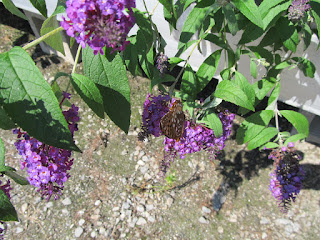 |
| Entrance to Battle Road Trail from Minute Man Visitor Center |
One of the benefits of living in New England is being surrounded by early American history. The events of April 19th, 1775, the day that marked the beginning of the Revolutionary War, are documented along the Battle Road Trail in Minute Man National Historical Park, Lexington, Massachusetts. The park is just a short distance off Interstate 93 and since I had a free afternoon last week after dropping friends off at Logan Airport, I decided to park my car at the Minuteman Visitor's Center and with a backpack, water and snacks, set out to explore the area. At the visitors center I picked up a map of the Battle Road Trail and learned that it would be approximately five miles one-way to the opposite end of the trail, at Meriam's Corner where the British retreat began. The trail goes past preserved houses and buildings and grave sites with historical descriptions along the way. It would be easy to spend an entire day learning about the events of that historic day.
 |
| Whittemore House |
|
 |
| Hartwell Tavern |
|
Even though it is only a short drive from the interstate, the park is surprisingly rural and provides a nice opportunity to step away from the traffic and congestion and appreciate nature, in addition to history.
The trail goes by and over restored wetlands. Above is a dried up blackberry bush filled with berries. It made me wonder why a bird or animal did not eat them when they were in their prime. Burdock (to the right) is an attractive plant, particularly in late summer when the pink flowers show. The plant is common in England and became naturalized in North America by English and French settlers.
A boardwalk goes over a beautiful wetland meadow abundant with cattails and wildflowers.
The site where Paul Revere's ride was stopped short by his capture, is memorialized at this monument.
He was released only a few hours later. Samuel Prescott, a Patriot who had joined Revere and William Dawes, escaped and continued the alert on to Concord.
Markers of grave sites can be seen along the route, like this stone marker for several British soldiers. It must have been difficult that first day, realizing that war had finally begun.
It's August, with the shortened days and cool evenings, mushrooms and fungi are everywhere, seemingly appearing out of nowhere. Below are examples of two interesting fungi I saw along the trail. I wish I were better at identification. The first one below looked to me like a Chanterelle, but since it was growing from a dead log, I know that it was not. Could it be
Laetiporus sulphureus or Chicken of the Woods?
 |
| Whatever this fungi is, it was very wet and seemed to be just starting to grow, a type of polypore? |
Just before arriving at Meriam's Corner, the trail goes around an active farm. Here there was lots of activity, from workers picking produce, to birds singing and butterflies sipping nectar.
 |
| Eastern Bluebird |
|
 |
| Common Sulfur |
|
A field of sunflowers had been recently cut. It seemed a shame that there were many flowers left on the ground to die without setting seed. I am not sure why so many had been forgotten.
I had originally intended to continue walking along the road all the way to the North Bridge in Concord, but after reaching the end of the trail, I realized that it would be adding five or six more miles to the ten-mile round trip walk and decided to save that portion of the park for another day. This was a good decision because by the time I returned to the visitor center, I was pretty exhausted, having skipped lunch as well.
 |
| The day started out drizzly, but ended with blue skies |
Resources:
http://fyi.uwex.edu/weedsci/1997/11/02/common-burdock/
http://www.botanical.com/botanical/mgmh/b/burdoc87.html
Minute Man National Historical Park - https://www.nps.gov/mima/index.htm




























